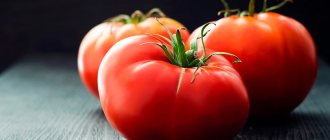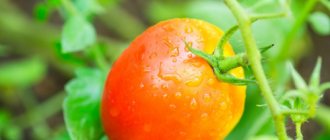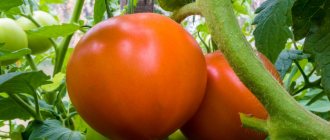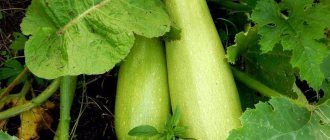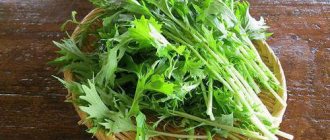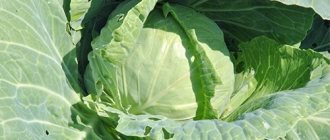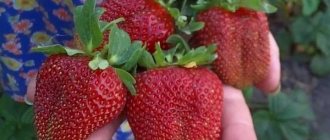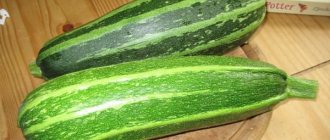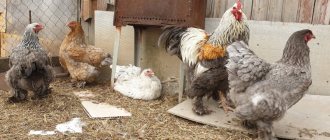We present to your attention a new selection achievement - the Spetsnaz tomato. Developed by Siberian breeders, the variety embodies unique resistance to any climatic factors. Its ability to bear fruit in extreme conditions has won recognition from residents of Siberia, the Urals and other regions with unpredictable climates.
The variety is distinguished by large, juicy and fortified fruits with high taste qualities that will not leave even the most fastidious gourmet indifferent.
Description of the variety
The culture was entered into the State Register in 2022, its author is Vladimir Nikolaevich Dederko, a famous breeder from Novosibirsk, who has developed more than one variety. Tomato seeds are spread by agro.
Distinctive features
Indeterminate type, height 1.5-1.8 m, moderate foliage, deep green leaves. The inflorescences are simple, the fruit-bearing branches are not branched, 3-5 fruits are formed on each.
Mid-season species, ripening occurs in two waves. The first collection lasts until the beginning of August, the second wave lasts until the end of September.
Productivity is high, from 1 sq. m harvest up to 10 kg, provided that 3 seedlings are planted per 1 sq. m. m.
The culture does not have stable immunity to fungal diseases and needs protection from late blight and alternaria.
Due to the active growth of shoots, regular pinching is required. Also, tall bushes need a mandatory garter, otherwise they will suffer not only from the weight of ripe fruits, but also from gusts of wind or precipitation.
Fruit characteristics
The fruits are large, the average weight during the primary harvest reaches 500-800 g. The secondary harvest produces fruits weighing 200-250 g. The shape is round, the color is raspberry-red, the taste is excellent, sweet, with a clear tomato sourness. The pulp is juicy, fleshy, there are few seeds. The peel is dense and not prone to cracking.
Universal purpose: suitable for fresh consumption and for winter preparations. Thanks to their durable skin, tomatoes can be stored for a long time and can withstand long-term transportation.
The photo shows Spetsnaz tomatoes.
Siberian novelty
The Spetsnaz tomatoes were created by the famous Novosibirsk tomato scientist Vladimir Nikolaevich Dederko. These vegetables underwent mandatory testing in open ground and greenhouses of farms near Novosibirsk and Altai. Then they were grown in other areas of the country. The research lasted several years.
Excellent test results made it possible to issue a state patent for the Spetsnaz variety in 2016. It was officially recognized as an outstanding achievement of Russian selection. In 2022, this new product was recorded in the Seed Register. The tomato is recommended for all regions of Russia where it is possible to grow tomatoes.
Breeder V.N. Dederko exercises author's control over seed production. The only official seller of Spetsnaz tomatoes is Novosibirsk Agro. Spetsnaz is not a hybrid, so every gardener can get his own varietal seeds from it. They are taken from typical second-brush tomatoes taken from the most productive bushes.
How to grow seedlings
The culture does not belong to a hybrid culture, which means it is possible to collect seeds for sowing yourself. Such seed requires special preparation.
Seed preparation
The seeds are carefully inspected for visible damage, laid out on the table one at a time. Grains suitable for sowing must be light in color and without distortion. Then prepare a saline solution by dissolving 1 teaspoon of salt in a glass of water. In this way, the seed is checked for internal voids. The grains that float to the surface will not germinate. The remaining seeds are placed in a pink potassium permanganate solution for disinfection. After 20 minutes, they are washed with running water and dried.
To increase the percentage of germination, grains are soaked in a growth stimulator for 10-12 hours. In addition to specialized drugs, aloe juice, melt water and potato juice are used as stimulants.
Container and soil
The soil is prepared from garden soil, humus and peat in equal quantities. A little washed river sand is added to the resulting mixture for lightness. After thoroughly mixing all components, the soil is disinfected to destroy pathogens. To do this, pour it with a hot solution of potassium permanganate or steam it in the oven for 10 minutes at a temperature of 60°C. After disinfection, the prepared soil is laid out in planting containers, with small pebbles or sawdust placed at the bottom.
Reference ! The drainage material at the bottom of the container is responsible for the effective distribution and outflow of water.
You can plant in a common wooden box and in separate containers, for example: plastic cups and peat pots. When sowing in peat pots, the seedlings subsequently require minimal care.
Sowing
The seeds are sown to a depth of 1-1.5 cm, the soil is slightly moistened with warm, settled water using a spray bottle and covered with film to create greenhouse conditions. The containers are left in a warm room at a temperature of 24-26°C, periodically removing the film for ventilation. As necessary, the top layer of soil is moistened with warm, settled water.
Growing and care
When the first shoots appear, the planting containers are moved to the windowsill. In the first week after germination, the temperature is reduced to 18°C. At this temperature, the seedlings will not stretch and become stronger. After a week, the temperature is raised to 23°C. The duration of daylight for seedlings is at least 12 hours. When there is a lack of natural light, phytolamps are used.
Water moderately with warm, settled water along the edge of the nursery using a shallow watering can. After watering, the soil is loosened superficially, without touching the young roots.
When 2 true leaves form, the seedlings dive, planting them in separate containers. When growing seedlings in peat pots, picking is not required.
Reference ! After the picking procedure, the plants develop more intensively.
2 weeks after picking, the first fertilizing is performed. 20 g of urea is dissolved in 10 liters of water and distributed 100 ml per bush. The second feeding is carried out 2 weeks after the first. 20 g of nitrophoska are dissolved in 1 liter of water.
Reference ! The main active substance of urea is nitrogen, which is necessary for the full growth of seedlings.
2 weeks before planting in the ground, the seedlings are hardened off by taking them outside for 1-1.5 hours at a temperature of 16°C. Gradually, the time interval is increased to 12 hours, while simultaneously reducing the night temperature in the room to 13°C.
Transfer
The Spetsnaz variety is planted in open ground in late May-early June, after the threat of spring frosts has disappeared. Before you start gardening, harden off the seedlings. For 7-10 days, take containers with seedlings outside, gradually increasing the time they spend in the fresh air (from 10 minutes to 12-14 hours).
The main indicator that tomatoes are ready for transplanting is the presence of one inflorescence and 6-8 strong leaves on the sprouts. It is important to have time to replant the plants before flowering. Choose the area in your garden wisely to create beds.
Please note that tomatoes do not grow well after potatoes, eggplant, peppers and legumes.
The planting site for tomatoes needs to be prepared in advance (preferably in the fall). The Spetsnaz variety is not picky about soil composition. The soil is dug up and leveled, fertilized with minerals. Make sure that the acidity level is not elevated.
If necessary, add lime or sand to the soil. 2-3 days before planting tomatoes, dig holes and carefully remove sprouted weeds. To destroy fungal spores, treat the soil with disinfectants (copper sulfate or potassium permanganate). Water the soil thoroughly.
It is necessary to plant seedlings in the evening, when there is no bright sun. When planting, seedlings are slightly buried in the ground. Be sure to water the young tomatoes with warm, settled water and compact the soil around them.
Plant no more than 3 bushes per 1 m² according to a 65x70 cm pattern. Since tomatoes are of the indeterminate type, they require staking. To do this, dig a wooden stake up to 1.5 m high next to each sprout, which will serve as a support for the crop.
How to grow tomatoes
After 2 months, the seedlings are ready to be transplanted into the ground. By this time, 1 inflorescence has been formed on the bushes.
Landing
The holes are prepared several days before planting, watering them generously with water. A little mineral fertilizer or wood ash is first placed at the bottom.
Planting pattern: 60 cm – distance between seedlings, 65 cm left between rows. For 1 sq. m place no more than 3 plants.
Replant on a cloudy day or in the evening, compact the holes, water with warm, settled water and leave the seedlings to get used to the new conditions for 1 week.
Further care for the Spetsnaz tomato
Regular watering is established 2 times a week, initially watering with warm, settled water at the root. When the ovaries form, the amount of watering is increased, since the plants need more moisture. But there is no need to create excess moisture in the beds; this will negatively affect the root system and the taste of the developing fruits. After watering, the soil is loosened, removing weeds with roots.
To retain moisture in the beds, they are mulched with straw. Mulch not only protects the soil from drying out, but also serves as a preventive measure in the fight against ground-based insect pests.
The culture is responsive to fertilizing. It is regularly fed with complex fertilizers.
2 weeks after transplantation, fertilize with mullein infusion in a ratio of 1:15. 500 ml of solution is used for each bush.
When the second cluster blooms, the plants are fertilized with chicken droppings in a ratio of 1:15 and 25 g of potassium sulfate diluted in 10 liters of water. The resulting solution is used for each bush: 1 liter.
When the third cluster is flowering, feed it with a full complex of mineral fertilizers in the amount of 1 liter for each plant.
Reference ! All fertilizing is applied after watering.
Features of care and possible difficulties
When planting in the ground, a wooden or metal support is installed immediately next to each bush, to which the stem is fixed. This technique helps the young stem quickly grow stronger and become even. As the fruit-bearing branches grow, they are also fixed to the support.
Another option for gartering is fixing plants on a trellis. To do this, supports are installed on different sides of the bed, between which wire is pulled horizontally. The stem and branches are tied to the wire with soft ribbons. This method of gartering is the most convenient, since the soft fabric does not harm the plant.
The culture needs regular pinching due to the large number of shoots. It is recommended to remove stepsons that have reached 4-5 cm. If you remove shorter ones, new ones will immediately appear.
Plants grow in 1-2 stems. This is the best option for obtaining maximum fruiting rates.
After harvesting the primary harvest, the tops of the bushes are pinched, thereby accelerating the appearance of new ovaries.
Diseases and pests
The tomato is especially hardy to changes in weather conditions, but is not very resistant to fungal diseases. One of its worst enemies is late blight. When infected, most of the plantings die, so preventive measures when growing tomatoes are especially necessary.
Prevention includes:
- moderate watering with control of the humidity in the beds;
- systematic loosening;
- weed removal;
- mulching beds;
- treating plants with fungicides;
- ventilation of protected structures.
Before planting tomatoes, the ground is spilled with a hot solution of potassium permanganate and treated with copper sulfate to destroy fungal spores.
In the fight against late blight, the systemic fungicide “Fitosporin” or “Hom” is used.
To protect crops from insect pests, plants are treated with insecticides or infused with decoctions of various strong-smelling herbs. The use of chemicals is possible only before flowering begins; traditional methods help throughout the entire growing season.
The Colorado potato beetle is collected by hand, carefully inspecting each bush from different sides for the presence of the pest. Pheromone traps are installed against whiteflies, which capture only parasitic insects without harming others. Also, to repel pests from the beds, strong-smelling herbs are planted next to the tomatoes, for example: calendula or mustard.
Features of agricultural technology
The Spetsnaz tomato variety is not for lazy gardeners. It is necessary to work hard to get the “double” harvest promised by breeders:
- The age of seedlings when planted in a permanent place should be 2 months.
- There are 3 plants per square meter of beds. You can't thicken it.
- Bushes and fruit clusters are tied to strong supports.
- Spetsnaz tomatoes lead to one stem, removing all the stepsons early.
- Towards the end of the season, the top is pinched off.
- The variety needs preventive treatments against diseases.
- Regular watering is required.
- Fertilizing is carried out every week, alternating organic and mineral fertilizers. The variety needs increased doses of potassium, magnesium and boron. On acidic soils, fruiting is weak.
Tomatoes of Siberian selection are loved by gardeners throughout the country. The new Spetsnaz tomato, according to its characteristics, promises to become one of the best large-fruited varieties. It requires special attention, which pays off with an excellent harvest.
Nuances for open ground and greenhouse conditions
Greenhouse bushes grow up to 1.8 m, while in open beds their growth does not exceed 1.5 m . Do not forget that in greenhouses there is often an increased level of humidity, which contributes to the rapid spread of fungal infections. To avoid diseases, the greenhouse is ventilated daily, without creating a draft. A regular influx of fresh air destroys the usual habitat of many greenhouse pests.
To increase the mass of fruits, only 1 or 2 ovaries are left in the lower fruiting clusters. With this technique it is possible to obtain vegetables weighing up to 1 kg.
Seeds for the next planting are taken mainly from the fruits from the second cluster. It is in these vegetables that the seed material retains the properties of the parent genes as much as possible.
The distance between greenhouse bushes during transplantation should be greater than in open beds, otherwise the plants will not receive enough light. In addition, dense plantings are possible, which will lead to the development of infectious diseases.
Care
Tomatoes need regular watering
It is not difficult to create suitable conditions for the active growth of tomatoes. Regularly water the seedlings, apply mineral fertilizers, form a bush and monitor the health of the sprouts.
Watering
Water not only helps seedlings develop quickly, but also protects them from overheating. Tomatoes need to be watered regularly (2 times a week). Do this in the evening, after the sun has set and the heat has subsided. Use warm water. To ensure that moisture is absorbed into the soil faster, do not forget to loosen it.
Water tomatoes in dry weather and during fruit formation. When irrigating, try to pour water not under the bushes, but between the rows. It is also important not to get it on plant leaves. Although Spetsnaz tomatoes love plenty of watering, you need to be careful not to overdo it. Excess moisture can have a detrimental effect on the development of fruits.
():
The irrigation rate is 4-5 liters of water per plant. During fruit filling, watering is reduced, watering no more than once every 8-10 days. Excess moisture during this period can cause delays in fruit ripening and deteriorate their quality.
Fertilizer
Spetsnaz tomatoes need to be fed with mineral fertilizers several times a season. For the first time, nutrients are added 14 days after transplanting the seedlings into open ground. Gardeners use a mixture consisting of nitrophoska and manure (1 tablespoon per 500 g), diluted in 10 liters of liquid.
The next feeding is organized during the period of active flowering of seedlings. At this time, tomatoes need minerals such as potassium, phosphorus and magnesium. Another option is to dilute 1-2 tbsp. l. chicken manure in 8-10 liters of water. Pour at least 800 ml of liquid under each bush.
It is recommended to periodically carry out foliar fertilizing with mineral fertilizers to activate fruiting. Mineral fertilizers will help strengthen weak shoots and speed up their development. For this purpose, a solution of urea, superphosphate, and potassium permanganate is used.
Bush formation
Indeterminate tomatoes of the Spetsnaz variety require not only mandatory tying, but also the formation of bushes. To harvest a bountiful harvest of large fruits, remove all side shoots regularly. Do not waste time on stepsoning. This will help the plant direct nutrients to fruit development.
Start forming bushes 2 weeks after planting seedlings in open ground. Repeat picking every 7-10 days. If you do not do this, numerous shoots will take away strength from the main shoot, preventing it from developing normally.
Protection against diseases
According to the characteristics, this variety is not resistant to fungal infections. The greatest danger to Spetsnaz tomatoes is a disease called Alternaria (translated as “moldy fungus”), which leads to the formation of rusty spots on tomato leaves, their lethargy and gradual death.
The disease is spreading quickly. The reason for the development of pathogenic microorganisms is high air humidity.
():
The most favorable condition for the development of Alternaria is air humidity of about 95%. In open ground, such humidity does not often occur, but in protected ground - in greenhouses - it is a common occurrence. Therefore, Alternaria blight is a typical disease for greenhouses.
Another disease, late blight, can cause great harm to seedlings. The disease manifests itself in the form of dark brown spots on the leaves and stem of the crop, and a whitish coating covering the entire plant. Shoots affected by fungal spores become weak, stop developing and die.
Special means will help overcome fungal infections. You can buy fungicides at gardening stores. To cope with the disease, spray the seedlings with solutions of Ordan, Quadris, Thanos. If plants on which fruits have already formed are sick, it is unlikely that they will be saved.
Harvesting and application
The first vegetables are harvested before the beginning of August, preparing the plants for the second wave. The second time, the vegetables ripen by September, but their size is already smaller.
Reference ! Double fruiting is a special achievement of modern selection, successfully embodied in the Spetsnaz variety.
The purpose of vegetables is universal, although the variety belongs to salad vegetables. They are used to prepare a variety of fresh dishes: hot, vegetable, summer salads, various snacks, pizzas.
For canning, use smaller tomatoes, collected a second time. They are also used to prepare pickles and marinades. Tomatoes are processed into tomato products, producing excellent juices, pastes, ketchups, and adjika.
Ripe vegetables can withstand long-term storage and long transportation.
Landing
Sowing Spetsnaz seeds must be carried out at least 2 months before the planned planting in the ground.
Seed treatment
Before sowing, tomato seeds must be treated. Disinfecting seeds will help prevent the possible occurrence of fungal diseases. When treating seeds the following can be used:
- peroxide solution
- soda solution
- potassium permanganate solution.
It is enough just to place the seeds wrapped in gauze in one of the solutions and leave for 30 minutes (in potassium permanganate), 10 minutes (in a peroxide solution) or for 24 hours (in a soda solution).
Germination of seeds
Treated seeds must be germinated in a damp cloth in a warm place. Ungerminated seeds should be discarded.
Soil for seedlings
Soil for growing seedlings can be purchased at a specialized store or prepared independently by mixing soil, peat and humus in equal proportions. The earth can be slightly calcined in the oven to get rid of fungus or harmful bacteria.
Sowing seeds
The following procedure is followed:
- Seeds are sown in holes 1–1.5 cm deep in moist soil.
- For better seed germination, cover the container with film and leave it in a warm and well-lit room.
- The film is finally removed when the first shoots appear.
Seedling care
The emerging sprouts require special care:
- Moderate but regular watering (you can use a spray bottle).
- After the seedlings have formed several leaves, picking is required to stimulate growth.
- Two-week-old seedlings must be fertilized with urea solution.
- After another 2 weeks, you can take the seedlings out to bask in the sun.
When to plant seedlings in open ground
Two-month-old seedlings can be transplanted into open ground. Usually by this time an inflorescence and several strong leaves have already formed on the sprouts
It is important to plant seedlings before they bloom. It is recommended to plant this variety in late May or early June.
Soil preparation
It is necessary to select a place for planting tomatoes in advance, prepare the soil (you can add sand or lime to the soil, treat it with a solution of potassium permanganate). A few days before planting, prepare the holes and water them abundantly. You can put mineral fertilizer or ash at the bottom of the holes.
Rules and scheme for planting seedlings
Plant seedlings in the ground in the evening (at sunset) or on a cloudy day. The seedlings are placed in the holes slightly deeper, the soil is compacted around them, and then watered with warm, settled water. The distance between seedlings and between beds should be at least 50 cm; there should be no more than 3 seedlings per 1 m2.
Caring for this variety of tomatoes should include:
- watering
- feeding
- garter
- stepsoning
- protection against fungal diseases.
This tomato variety is very fond of fertilizers, so you need to feed the plant several times during the summer. The first feeding (1 spoon of nitrophoska + 500 g of manure + 10 liters of water) can be done within a few weeks after planting the seedlings in open ground. The second feeding (chicken manure and water in a ratio of 1 to 15 + 25 g of potassium/magnesium + 10 l of water) is carried out during the period of active flowering of the 2nd tomato cluster. The third fertilizing (a full complex of mineral fertilizers) is recommended to be carried out when the 3rd cluster of the plant is flowering.
Immediately after planting the seedlings in open ground, next to the holes, it is necessary to dig a support more than 1 m high, which will subsequently secure the stem.
The Spetsnaz variety needs regular (at least once every two weeks) removal of excess shoots about 5 cm long (pinching).
Advantages and disadvantages
The main advantage of tomato is double fruiting. In addition, culture has a number of other advantages:
- ease of care;
- cold resistance;
- fruit setting in any conditions;
- high fruiting rate;
- takes root in all regions;
- excellent taste;
- large fruits;
- versatility in cooking;
- long storage;
- long transportation;
- possibility of independent seed selection.
The negative aspects include:
- Garter required;
- regular stepsoning;
- average resistance to diseases.
Advantages of tomatoes
Diligent breeding work culminated in the development of a tomato that is perfectly suited to the test of weather vagaries. And at the same time having high rates of fruiting.
- High stable yield;
- Large fruit;
- Excellent taste and excellent appearance;
- Strong plant structure;
- Unpretentiousness, resistance to harsh climatic conditions.
It should be noted that a plant of this variety must be protected from fungal diseases.
Farmer reviews
Most of the reviews about the new variety come from Siberia. Gardeners note the excellent taste and large fruits, even with a short and rainy summer season.
Roman, Omsk region: “I planted several Spetsnaz bushes. The package with the seeds said that you can get a double harvest. And so it happened. At the very beginning of August I removed all the large fruits, and by September many more had grown, only smaller in size. The tomato convinced me with its persistence, despite the bad climate.”
Nadezhda, Altai Territory: “I planted a tomato in a greenhouse. During the growing season it gave a lot of organic matter. The fruits reached a weight of 400-600 g. Excellent taste, good yield. I will definitely continue to grow it. The seeds were collected from the largest tomatoes of the first wave.”
Bush type
The author of the variety, V.N. Dederko, notes that Spetsnaz works better not in greenhouse conditions, but in street beds. The tomato turned out to be unpretentious and strong, like a special forces soldier.
Interesting on the topic:
Wireworm in the garden: how to fight
Jan 12, 2022
If cucumber leaves turn yellow, this may be a signal of...
Jan 12, 2022
The height of indeterminate plants in open ground is one and a half meters. The garter requires the installation of strong stakes or trellises. The leaf apparatus is of moderate length and density. Stepchildren grow actively and require regular removal.
If the Spetsnaz variety is nevertheless placed in a greenhouse, it is necessary to organize good through ventilation and protection from infections. Don't let it get too hot, otherwise the tomatoes won't set.
Growing rules
For seedlings, seeds must be sown at the end of February or at the beginning of March. To do this, take a shallow container with a tray. The soil should contain coarse sand, peat and turf soil.
The holes for the seeds are made shallow, maximum 2 cm. The container is covered with plastic wrap and placed in a warm place until the first shoots appear.
As soon as the first shoots appear, the film is removed and the seedlings are transferred to a more illuminated place, where the temperature is kept between +22...25°C. Diving is done in peat pots or disposable cups. Before planting in the ground, seedlings need to be “hardened off”. To do this, take it outside for 1 hour for another week.
Plant the seedlings in well-fertilized soil. For this, it is best to use nitrogen and potassium minerals. Many farmers prefer to use humus to enrich the soil.
Bushes are planted in groups of 3. per 1 m². The age of the plants by this time should be 2-2.5 months. After planting Spetsnaz tomatoes, it is recommended to mulch the holes with sawdust or dry grass.
After 10 days, the bushes are fed with complex minerals. Caring for the Spetsnaz variety consists of regular watering with settled water, weeding the beds and loosening the soil, and constant feeding with organic and mineral fertilizers. By the end of the season, mature bushes need to be pinched. This will stop their growth.
The Spetsnaz variety needs protection from fungi and pests. Therefore, it is necessary to periodically carry out preventive spraying of bushes. Chemicals can be used until the first fruit ovaries appear on the branches.
Tomato Spetsnaz receives the best reviews from those who have already planted it on their plots and appreciated its qualities.
Protection against diseases
To prevent late blight and Alternaria blight, Spetsnaz tomatoes should be regularly sprayed with fungicides, for example, Ordan, Quadris, Thanos and others. The first treatment is carried out at the stage of 4-6 leaves, the next after 10 days. Plants with ripening fruits are not treated.
Read also: Pruning pears in autumn: columnar, two-year-old, three-year-old, old
The new variety of tomato is confidently gaining its place in gardens and summer cottages. The fruits, amazing in size and tasty, reward the efforts of gardeners to grow tall bushes.
Secrets of cultivation
Spetsnaz tomatoes are mainly grown in open ground, but they can also be planted in a greenhouse.
Important! It is necessary to sow seeds for seedlings no later than 2 months before planting them in the beds. To prevent the development of various diseases, experienced gardeners recommend pre-treating the seed with a weak solution of potassium permanganate.
Seeds need to be wrapped in gauze and placed in the solution for 30 minutes.
To prevent the development of various diseases, experienced gardeners recommend pre-treating the seed with a weak solution of potassium permanganate. The seeds need to be wrapped in gauze and placed in the solution for 30 minutes.
Seeds
Then they need to be germinated, this will increase their germination rate several times. To do this, the seeds are placed on damp gauze and covered with damp cotton wool or cloth. They should be kept in a warm room, moistened with a spray bottle as they dry. The germination process lasts no more than 5 days.
Important! Seeds that have not germinated should not be used for sowing. You can plant seeds in special nutritious soil, it is sold in stores
You can also cook it yourself. To do this, peat and humus are mixed in equal parts. Seeds are planted to a depth of 1.5 cm
You can plant seeds in special nutritious soil, it is sold in stores. You can also cook it yourself. To do this, peat and humus are mixed in equal parts. Seeds are planted to a depth of 1.5 cm.
Containers with sowed seeds are placed in a warm and bright place. The room temperature should be at least 25 degrees. It is recommended to cover the containers with transparent film. This will prevent the soil from drying out and speed up the process of the first shoots appearing.
After the first 2 leaves appear on the seedlings, the film can be removed. At this time, it is necessary to provide constant lighting to the seedlings, otherwise they will stretch and weaken. If the spring turns out to be cloudy, additional illumination with phytolamps will be needed.
Seedling
After 2 weeks, the seedlings need to be pruned. Seedlings should be planted in open ground only after 6-7 true leaves appear on the seedlings.
Important! You cannot plant tomatoes in a place where eggplants, peppers or potatoes were previously grown. Seedlings can only be planted in well-warmed soil, otherwise the plant will get sick.
It is recommended to plant no more than 3 bushes per 1 m2. This will help prevent shading
Seedlings can only be planted in well-warmed soil, otherwise the plant will get sick. It is recommended to plant no more than 3 bushes per 1 m2. This will help prevent shading.
Tomatoes of the Spetsnaz variety need good watering. Gardeners recommend watering plants every other day with warm, settled water after the heat subsides. Under no circumstances should the soil be allowed to dry out while the ovary is forming. This may cause it to fall off.
Watering tomatoes
Plants need feeding. During the season, it must be carried out at least 3 times: after planting, during flowering and when ripening 3 brushes. For feeding, you can use fertilizers purchased in special stores. A solution of 10 liters of water and 500 grams of chicken manure is also suitable.
Important! It is imperative to remove side shoots. This will help form the correct shape of the bush and will promote the formation of a new ovary
With the correct watering regime and timely fertilizing, a good harvest of tomatoes of the Spetsnaz variety is guaranteed.
Landing
Sanka is ideal for growing “using lazy technology”. This means that the variety is unpretentious, does not require special care, grows successfully and produces a harvest for people who, due to their busy lives, cannot devote much time to garden work.
Growing seedlings
Seedlings are grown in boxes with small sides. They are filled with prepared soil, saturated with peat and turf. Water until slightly moist, then lay out the seeds at a distance of 1.5 cm from each other, 2 cm deep. Lightly sprinkle with earth. If you plan to grow vegetables in a greenhouse, then the seeds are planted in mid-March, if in open ground - in mid-April.
Landing in the ground
The variety performs well when planted in open ground in regions with cold climates, for example in Siberia. It is necessary to plant seedlings in open ground when the threat of return frosts has passed. The bushes are tied up and the ground is mulched with cut grass.
